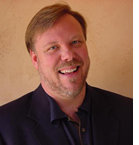

 |
Dr. Alan Greene is the Chief Medical Officer
for A.D.A.M. He is
also on the Clinical Faculty at Stanford University School of Medicine,
where he sees patients and instructs residents. He is a graduate of Princeton
University and UCSF Medical School. He has had a powerful Internet connection
with families around the world since co-founding DrGreene.com in 1995. He has conducted daily live chat sessions on
the web for over three years. He is a founding member of Hi-Ethics (Health
Internet Ethics). In 1999, Intel named Dr. Greene the Children's Health
Hero of the Internet.
|

On Being A Physician: A Day In The Life
Dr. Greene receives numerous requests from high school and university students,
who are in the midst of choosing a career, asking what it is like to be a physician.
Here is Dr. Greene's reply --
It was a bad hair day.
Two hours earlier, I had been dreaming happily of flying over the beach at
Cabo San Lucas -- without an airplane -- when the harsh ring of the phone burst
the scene into quickly forgotten fragments. It was a call from the hospital;
they needed me for an emergency Cesarean Section. After a blizzard of activity,
the emergency was over, and a picture-perfect little girl had been born. Still
awash with the glow of the miracle of birth, I glanced at my watch. The emergency
had come at that awkward time when I would normally be home showering. Instead,
I shaved in the on-call room (no time for a shower), rushed through the cafeteria
line, and ate breakfast while walking to my office. I am a pediatrician.
I arrived late, harried, and wearing part of my breakfast. I know that it's
a very minor inconvenience, but the feeling of wearing a stained shirt or having
unkempt hair embarrasses me. I was not looking forward to the rest of the morning.
The waiting room was jammed. The first few patients I saw were delightful children
I already knew, who had come in with minor complaints. I sped through the morning,
pausing to smile at each child, but hurrying to get back on schedule.
The next chart in my in-box had an unfamiliar name on the cover. I stepped
into the exam room and saw a nine-year-old boy. Large clefts marred the middle
of his face. Although a scar suggested that his cleft lip had been repaired,
he was still left without nose or eyes. He did wear glass eyes in an attempt
to make his visage more presentable.
"You must be Stephen," I smiled, "I'm Dr. Greene." I reached
forward, took his hand in mine, and shook it warmly. The hand at the end of
his shortened arm was missing three fingers.
I recognized Stephen's condition as the Amniotic Bands Sequence, which affects
only about one in 25,000 otherwise normal children. When Stephen was still waiting
to be born, his forming face fused to the membrane lining of the amniotic sac.
Normal development arrested, resulting in the large clefts in his mid-face.
Part of the amniotic membrane ruptured, and the sac that was supposed to protect
him, instead entangled his developing limbs in shriveled, fibrous, amniotic
strands. Decreased circulation to the limbs caused multiple deformities and
amputations. Normal intellect and normal emotions were framed in a twisted,
blind body.
"I'm glad this sweet boy will never see his own face," I thought.
Thumbing through his chart, I looked up to ask a question, and saw tears making
their way down the crevices of Stephen's face. Mild surprise that his tear ducts
functioned gave way to genuine concern over what had made him cry. I placed
my hand gently on his shoulder and asked what had provoked his tears.
"I'm just happy, Dr. Greene... you smiled at me!"
This boy with no eyes had felt my smile, just as he had felt the averted gaze
of many passers-by. And the smile had touched him deeply.
How striking that a gift as simple as a smile could be so powerful. When we
see someone afflicted, whether emotionally or physically, it is easy to turn
away. What an important act of humanity to look in the eyes (even if there are
none), and see a person, not just a problem.
But it's not just the disabled who need reassurance. In our mobile society,
our moorings both to place and to people have been loosened. We are adrift in
a rolling sea of humanity. By looking with fresh warmth and compassion at the
people who surround us each day, we create new connections. By seeing beyond
surface appearances to the unique miracle of each individual, we are all buoyed.
As I stood in the exam room with Stephen, the two of us beaming at each other,
we both felt beautiful, bad hair day and all.
P.S. Stephen went on to have plastic surgery on his face, despite others' objections
that he did not need it, since he was blind. He is an absolutely delightful
young man, and I am honored to count him as a friend.

Created: 7/30/2002 - Dr. Alan Greene



